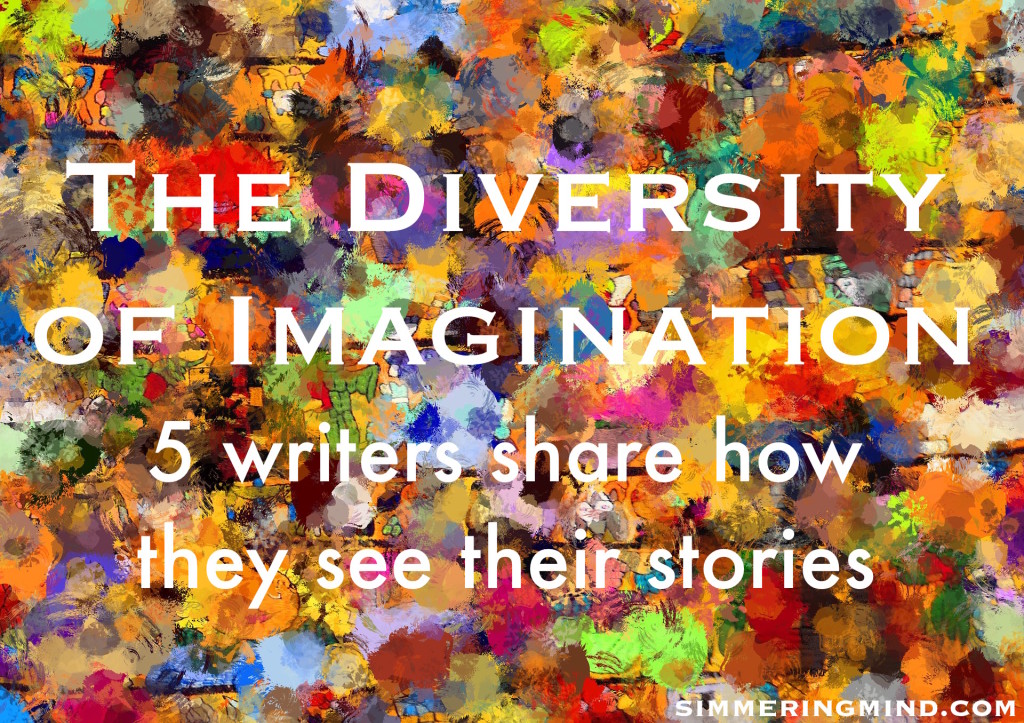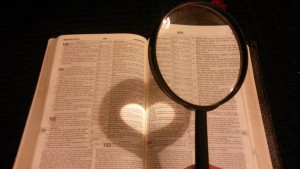I love to hear about how radically diverse our souls and minds are, as human beings. It’s part of why I love Myers-Briggs so much. It’s delightful and mind-blowing to me how very differently people can approach similar things! It’s what makes the world exciting and fun, that none of us quite think the same way. It’s why our souls are so endlessly fascinating and we can keep getting to know more about one another forever.
Over the past week, I’ve been thinking specifically about writers and how we approach the task of getting to know our stories.
5 Different Imaginations
All my musings were sparked when I spoke with a writing friend, Janeen Ippolito, about our different approaches to writing and how our imagination handles our stories.
Janeen Ippolito – A Puzzle Approach
Janeen explained her approach like this:
I’m a major story collager. … I’m constantly moving pieces of story around into different realms. Stories, plots, characters, settings, creatures, all of those things. I’ve had plenty of things not fit and then are much happier other places. It’s making a system where everything fits and making the characters truly happy and fulfilled psychologically, emotionally, and spiritually. I handle it a lot like therapy. Tough love character and plot therapy.
Janeen’s approach sounds to me like her imagination dumps out a ton of puzzles into a heap, and she’s organizing and sorting and fitting everything where it ought to go. Sometimes a puzzle piece ends up in the wrong box and has to be moved. She’s on a mission to make sure everything fits in where it should. She often closely examines a character and digs deep down to understand what they need, and what their true place is.
Bethany A. Jennings – A Painting Approach
Janeen’s approach was so foreign to me! Move an element from one story to another?? I almost never do that. If I invent an element for one story, even if I delete it entirely, in my mind it still “belongs” there. The way I think of my writing projects is entirely different.
I explained my approach like this:
I look so much at the integrity of the whole idea, as a whole. … For me it’s like taking a vision and fleshing it out until it is complete and whole and vivid, going down to the nooks and crannies to understand it and make the finished product as epic as the glimpses I got in my head.
For me, getting to know my stories is more like painting a picture. I have a vision in mind from the beginning. I sketch it out. I add more detail. I add color. If something I visualized doesn’t look right on the canvas, I paint over it with something else. To me it makes no sense to then take the painted-over element and draw it on another canvas elsewhere!…it’s still there down under the top layer, quietly tucked beneath the finished masterpiece. It might never see the light of day, but maybe it still provides a little bit of color or form to the finished product. Each book is a painting of its own, some of them roughly sketched and some fleshed out to bright color.
RJ Conte – An Investigation Approach
Very different from either of us is my friend RJ Conte (who is an ESFJ). Drawing her inspiration mainly from real life experiences and the people around her, she described her story-forming process as:
For me, it’s a character or a scenario that boggles my mind and makes me think, and then it’s figuring out the deepest recesses of that character’s heart as he or she goes through the situations life has thrown their way. Like saying, “Why WOULD someone do that or respond that way?” or “How would someone like that change?”
As many of her stories are issue-driven contemporary works, RJ considers her approach to be more like an interrogation or deeply getting to know a person and understand how they tick. All other story elements are built around the characters and their relationships that are unique to each story, many of them drawn from her own experiences.
K.M. Carroll – A Snowball Approach
K.M. Carroll, another speculative fiction writer, has yet another completely unique approach to finding and understanding a story. She said:
There’s this strange game called Katamari, where you roll a ball around and stuff sticks to it. First you’re collecting lint and paper clips and crayons, then you’re catching furniture and trees and buildings and clouds and rainbows. The idea (I think) is to collect enough mass to build a star. For me, building a story is like that. I start with a concept. Then I roll in characters. Then I build on their arcs and goals. Then I collect more cool worldbuilding ideas, and the ball gets bigger and bigger. But I can’t start writing until I find the Oomph, the magic, the particular sparkle that makes me excited to write it. That’s when it becomes a star.
H.L. Burke – A Casual Stroll Approach
H.L. Burke, an ENFP, has a more laid back approach than any of these:
It’s like taking a walk for me. I know where I’m going and generally how to get there, so I just start walking through the world, heading towards my story’s ideal conclusion, sometimes with highlights I want to see along the way, sort of how I might go into town for the bank but know very well I want to stop at the coffee shop and maybe browse the bookstore next to the bank and if I have time take my kids to the playground. This usually happens pretty instinctively and impulsively. I don’t pre-think my books much. They sort of spring fully formed from my head, wearing plate armor and all that. I may get distracted a few times along the path. I may meet someone along the way and end up talking to them for longer than I mean to or ask them to join me in my errands when I didn’t plan to, but I almost always end up at the destination I’d originally planned, maybe just with a few unplanned detours. My first drafts are also very similar to my final drafts. I rarely make big changes once things are on paper. I’ll make little changes all over the place, but big changes, not usually.
Each Writer Unique
My guess is that each one of us has a different way of imagining our stories, a different emotional approach to seeing and interacting with the ideas, and a different way of shaping them into the finished product. It might even vary from book to book, too! Perhaps writing The Kraesinia Trilogy feels like endlessly adding layers to a painting because I’ve been revising for years…I’ll be interested to see how writing a brand new draft of a book will feel to me.
I’d love to hear how your imagination works, fellow writers. Is it like any of the approaches above? Or is it entirely different? Let us know in the comments!







I love this! I’ve had two different approaches for both my books. In the first, I was a story collager, like Janeen, where I moved scenes all over the place. But in my next series, it was definitely more like like a painting approach, like you. There was no way I could move scenes around in my second series without messing up the whole story. 🙂
Interesting, Sara! But what do you do when you have to cut a character or some other important element out? Do you move things into other stories so you can use them again anyway?
You know what? I’ve never cut out a scene or character that I’ve absolutely loved. I have merged secondary characters together into one, but if a scene or character doesn’t really have a place in the story, I chop it out and don’t use it in a different book. I just label it a writing exercise.
That sounds a lot like me. 🙂
I usually start with an idea – a what-if. Or a scene leaps into my mind fully formed and I mull over the 5 Ws. I’m an outliner – it isn’t detailed but I can’t start actually writing until I know where my characters are going – what the basic ending is going to be, and have a vague idea how they are going to get there. Similar to H.L. Burke’s approach, I think. Then as I write, I’m still mulling things over in my head, thinking about side-characters and ways to fluff the plot a bit.
As for scenes, yes, I totally do that. They aren’t physically written down (though a box of index cards sounds like an awesome idea) but I have a mental Rolodex of scenes that I would like to use someday and those scenes get held up to every story to see if a few of them might fit or if I need to keep holding them for another day.
Ahh, how neat! Scenes you want to write but don’t know what story they go to! I keep tiny notes on my computer with any little “snippets” like that, but I tend to treat them each as an individual entity and am waiting for the rest of *that story* to manifest itself.
This is so different from me. Fascinating.
Wow, what a fun post! 😀 I fall somewhere between the “puzzle” and “painting” approaches. I have a clear sense of what I want each story to “feel” like and the direction it is ultimately heading. Each scene and character and visual metaphor is deliberate and I frequently step back to consider the big picture (and yeah, I write pretty slowly, haha!). Somehow, though, things never quite go as planned. Characters decide they don’t like the plot I’m forcing on them, or want a different love interest. Aspects of one magic system or invented culture end up working better in a different world. Major characters have hidden motivations/desires/needs that end up taking the story in an unexpected direction, or even force me to completely start their story over. I always reuse or rework deleted scenes and characters I like, and pieces often jump from one story to another, sometimes without permission. Most recently, the main villain in my backburner WIP sneaked over into Dragonfly when I wasn’t looking. I let him stay – he’s much happier there, and his brand of nastiness fits the story perfectly. :p
Gotta love it when the intuition steps in and says, “Nope, I’m doing it differently!” 😛 You do sound similar to Janeen! 🙂
Intriguing! I too find it fascinating how unique each human mind and personality is. I just took the test a couple days ago for the first time, and found out I’m an INFP. I’d say, at least for my current series, my process has been similar to K. M. Carroll’s, the snowball approach. I started with a few very specific and small details, and gradually the story grew out of those into a vast world. When the first tiny sparks leapt into my mind, I had no inkling of an entire world waiting to be born. I was just entertaining myself on my daily walk to class in college. 😉
Ahh, an INFP! I know many. 🙂 Very neat.
I tend to be an investigative storyteller. My characters, for instance, grow and develop as I get to know them. I usually start with a general premise and a rough (very ) outline and then ask questions of the characters and the story. There is certainly an element of ‘seat-of-the-pants’ to this approach but I feel it gives the story an honesty and plausibility ( even for spec-fic ) that I truly desire to convey. I am still required, of course, to perform the requisite heavy lifting of editing and reorganization but even those tasks are ordered by questions: “How did he/she/it get to this point?”, “Would the narrative make clearer sense if I pulled this out or shifted this to over here?”, et cetera.
How neat, Jim! Another investigator, but pantser style.
Yeah, it’s like mine + Heidi’s. What personality type are you, Jim?
Very cool! I’m an ISFJ. I tend to have a very emotionally charged scene in my head that I build up to. Sometimes I have two people, generally a romantic relationship, that I’m excited about. I explore their relationship in different real life situations. Then I plug them into this emotionally charged scene and build them and the story up to that one point. Sometimes it’s half way through the story, sometimes it’s the end, sometimes it’s the beginning. The parts of pure imagination almost never have fantasy involved. When I sit down to write, magic pours in. I guess in a way I’m like you Bethany and a bit like K.M. Carrol, and a bit like Burke. lol. I have no idea who I am!!!
That’s fascinating. So you’re drawing from real life but then your imagination supplies fantasy elements. I love it!
I’m a little like HL Burke – casual stroll – but I’m also like a ripple in a pond. The idea plunks into my head with all sorts of ripples, well, rippling out. And underneath, where the idea sits on the bottom, the course of the water is forever changed, even though you may not see it. That change comes from asking the usual “what if” but also “why”. So while I’m strolling, the ripples are rippling, and I’m asking questions, and the basic idea sits while the waters flow around it. Sounds kinda poetic, huh? 🙂 It’s not a quick process, but I guess it’s not supposed to be.
Ooooh, I love your poetic visual. Thank you for sharing that!
XXTJ here. I might be a little like Pam. I’m finishing up a book (and always finishing, like Zeno’s Paradox. I think I’ve achieved the perfect text, and then I show it to the editor again.) that started in this way: Setting: my son’s universe. MC, my son wants me to write about a species I’ve not had in the prior books, so I don’t know much about these guys yet. We talk around and around the species and what makes sense and how do I explain these things Josh has drawn. So far, all we have is an idea. Still no story. We talk about what this species would want out of life and what would hinder the getting of that. I mention that we should put a human somewhere in the story so people can identify (like the Hollywood rule that you can have blacks in a movie, but the rescuer or coolest guy has to be white. A STUPID rule, but one that Hollywood producers live by) I’m thinking of one guy caught by the hunter species, dragged home, and enslaved. But what could a human contribute to a people who are twice to three times the size of humans? Josh talks about a caste of slaves. I can’t see it. How would humans live long enough to reproduce on the ice where this species lives?
So far, still only an idea exists. No story yet.
We kick around what the species eats, what humans could do for them they can’t do themselves, what kind of homes they live in, and how somehow I need to put in the story great sea creatures towing an iceberg up a river. Riiiight…..we google icebergs, floes, Antartica, the Arctic, ice caves, ice palaces and I try to think of a way to talk him out of the icebergs up the river thing. Josh draws maps and we think about the species these kruli live within paddling distance of, species and geography I have written about in prior books.
We’re almost within reach of a premise. No story yet.
Why are these kruli riding an iceberg that is being towed up a river? Why why why? We brainstorm over the course of days. As we’re passing each other in a hall, Josh says, “What if we reworked a Bible story.” I’m about to say how I love reworked Bible and myth stories when he adds, “Like Joseph when he was a slave.”
BOOM! I have the story.
And then I write The Melting Kingdom. We tussle over a few of the chapters until we arrive at a shared vision both of us are happy with.
I think our method is a little like Randy Ingermanson’s Snowflake Method.
Wow, that’s a fascinating process, Lelia. I love it! It throws a whole new wrench in the works to be writing collaboratively.
I’m going to guess ISTJ from this. 😀
So much great detail!
Actually XXTJ, with X being 50% both. Balanced, I am.
This blog post is very well pet together and makes for fascinating read—both regarding the imaginative process and the side note about MBTI.
I sort of feared MBTI was really horrible when it first started invading my mind, though I identified with the Jungian cognitive process for my type quite strongly. The grip experience of inferior extroverted thinking helped me analyze my impossible quest for absolute answers while simultaneously being unable to fully accept the legitimacy of any human narrative or finite interpretation. I thought I was losing my soul, but then I found your older posts about MBTI and saw that a much more confident Christian made peace with it. You’re right—when used well MBTI can bring us to appreciate how alien we all are from each other, how multifaceted the imago dei is.
I don’t think MBTI is comprehensive or even universally applicable, but it can do a good job of describing many people’s inner process. I happen to fit the INFP model quite well.
So, a sincere thanks for helping me retain my sanity!
I have several worlds in my head, and I choose the part of one of my worlds that best fits the particular problem that I need to address at this particular moment to advance the story.
Wow, I love your comment, Paul. Thank you for telling me my posts encouraged you! I’m so glad. 🙂
Thanks for including me, Orrie! I love reading the comments. 🙂
I’m an INFJ and my process is like yours. A painting. ^ ^
storitorigrace.blogspot.com
Ahhh, fascinating! Thank you for stopping by! 🙂